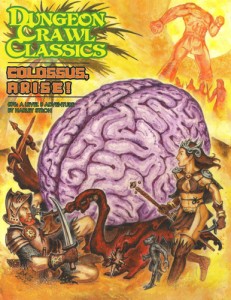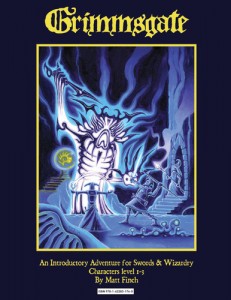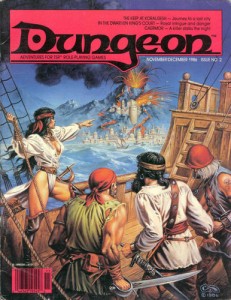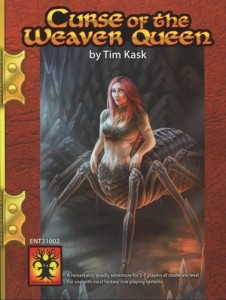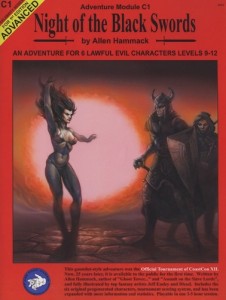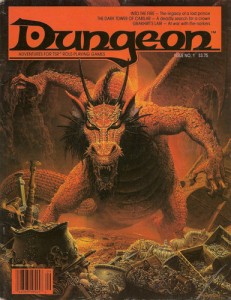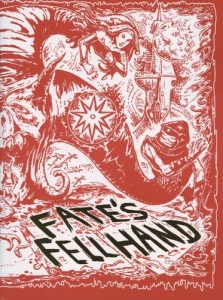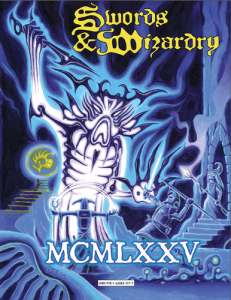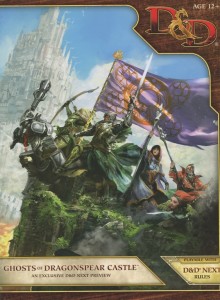
by Jeremy Crawford & Christopher Perkins
D&D Next/5E
WOTC
Levels 1-10
WOTC has done about as well as can expected with this adventure. It contains a lot of very very good content in it; a great number of good ideas and ‘advice through examples.’ It’s also a railroad with a whole of bad ideas thrown in … but maybe that a given these days, at least the railroad part anyway. I suspect the real goal of 5e/Next is to produce content that the entire range of D&D editions can use, as well as the Pathfinder crowd. I don’t think this product does that. But it is close … a lot closer than anything that has come before. It’s close enough that I’m keeping an open mind and will buy the next one.
This 288 adventure is broken in to four parts and also contains a playtest version of the 5e/Next rules. The playtest rules take up about half the pages with the rest being the four adventures. The booklet is designed to take players from level one to level ten. I’m going to ignore the rules and instead concentrate on the adventure and speak a bit about the presentation. Haters gonna hate, so let me get that part out of the way first before I comment on the good … and there’s a lot of good. This review concentrates mostly on the content in the first adventure, although most of the comments apply to the other four as well. (I took good notes in reading the first adventure but not in the others.)
First, the outline. There are evil guys. They have a plan. They need four keys. The players slowly unravel the mystery. Blah blah blah. It’s the usual stuff. It’s a set of linked adventures and I’m almost certain that it’s going to be tied in to another product and/or set of adventures.
Therein lies the first problem with the product. One of the first things the adventure tells us is “The adventures are structured in such a way that makes it difficult for the characters to obtain the four keys. Even if the characters do everything right most or all of he keys are likely to end up in the bad guys hands.” In other words: there’s no point to this adventure. The players can not impact it or change the destination of timing of the railroad they are on. You might find the ride enjoyable. This is not the freely structured adventures of the playtest modules, like B2, X1, or the others. This is more like the best D&D Encounters adventure ever written, except it takes a lot longer to find out that your characters actions were meaningless. This is consistent with what the D&D team are saying. They want to “concentrate on telling great stories”, according to at least one published statement. This then is the primary sin of the product. Either you are ok ‘telling a story’ or you want a setting to explore. This product does NOT marry those traditions and in that respect it’s a fail. I suspect that the adventure could have been restructured to make it more of a setting with personalities and locations and thereby accomplish both goals by providing an outline of how the adventure usually works (the railroad.) As it is the thing is written in such a way that it’s clearly broken down in to four parts to be completed sequentially and without deviation. It is not going to be easy to restructure it on your own.
There’s another example of this plot railroad that sets up in the first adventure. A shapechanger means someone important harm. Clearly the designers are setting up something to happen in a later adventure but, this being D&D, secrets are hard to keep. You have to keep the mole alive and their identity hidden in order to get the payoff later but D&D is FULL of magic that prevent you from keeping secrets. This typically means the designer has to jump through a lot of hoops: rings of non-detection “immunity to mind reading” and all sorts of other VERY forced things, all in order to try and mislead the players. This adventure does that. A powerful NPC could kill he party at any time but instead watches them, tricks them, lies to them, and so on, all disguised. That’s a pretty bad description of what’s going on and it KIND OF sounds ok. It’s not. The actual situation is much worse and should not have been included. It’s leading the party around by the nose and smacks of a DM’s pet NPC. It’s low & common. Given the excellent ideas in the rest of the book they should have been able to come up with something else.
Finally, there’s a very common mistake. You have to pass a skill check to go on the adventure. Seriously, if you fail the check then you don’t get the information needed to go on the adventure in the first place. Easily fixed, right? The DM just feeds the players the information … after all, that’s what’s actually going on. Someone makes the check and the DM feeds them information. What exactly is the point of the skill check then? Just roll a die and give it to someone. Or better yet integrate it in to the adventure. The whole adventure does a great job of integrating learning examples in in to play but this is not one of them. It reminds me of why I hate skills in games. People don’t know how to integrate skills and skill checks in to games. Not even the designers, evidently. This is NOT the correct way and by placing it in an introductory product you are tacitly telling people this is how the game is played. (More on that later.) Someone who knows how to use a skill check should have caught this in the edit and fixed it. I know, that’s a lots of complaining for something simple but the published adventures are how people are going to learn how to play the game. If they are crappy and consist of nothing more than combats then that’s how people are going to play their home game. If they are nothing more than Tomb of Horrors deathtrap suckfests then that’s what people are going to think the game is and they are going to emulate it. Skills, in particular, are very hard to integrate in and deserve VERY good integrated examples in these early products.
There’s another example of ‘bad play style’ (or maybe “substandard stye”) in a green slime room. There’s a green slime above the interior doorway of a room. A character opens the door and slime drops on them when the first character passes through the door. That’s ok but it could be far better. A simple note like “waiting a bit will allow the characters to notice a bit of slime dripping from the ceiling” or something similar about seeing slime on the floor. Maybe the floor glistens, rewarding characters who ask why. It’s not the fact that you can never have a slime ball drop on a player but rather this is an excellent teaching opportunity to pass on a certain play style. It’s the back and forth between players and DM that D&D thrives on, especially the exploratory aspects of D&D.
Let’s talk read-aloud text. There’s a lot. WAY too much. WOTC has published articles about the problems of read-aloud text, but they still do it poorly. I was trying to find a reference I came across once. It said something to the effect that players eyes glaze over after two or three sentences of read-alound. I think it was a WOTC article but it may have been on rpg.net or therpgsite. I know my eyes glaze over when reading it and I stop paying attention when someone is droning on … where droning on is … about three sentences. I LOATHE the long read-alouds. I know they are supposed to be evocative. I don’t care. It’s far far better to provide some terse but evocative descriptions to the DM and keep the read-aloud VERY short … if you have to include it at all. This has A LOT of read-aloud, almost none of which does anything required at all. It doesn’t provide good play examples or communicate important things by doing something specific. It just sits there and increases page count and acts as something for the DM to read and not care about and for the players to ignore.
Speaking of verbosity … this thing has a lot of meaningless stuff in it. Sometimes it seams like every rock and bush has a motivation that needs to be spelled out and described … rocks and bushes the PC’s will never encounter. SOmeone has clearly gone to a lot of trouble to try and make every one and every thing work together, but it’s too much. All of the words just run together and make it hard to find information. All of the verbosity in both the room texts and in the general background sections need a SERIOUS edit. Everything is spelled out for the DM in a painful level of detail. The product doesn’t need this. Provide a general outline and reveal more of it in the text of the encounters and focus on providing flavor seeds rather than specific details. DM’s need enough information to get their imaginations going so they can fill in the rest, not a level of detail that tells them how the price of tea in china impacts the fluttering butterfly wings in Canada on April 3rd 318 years from now. I want terser descriptions and explanations that contain the flavor of the thing. This sometimes extends in weird ways. The monster stats are not included in the adventure text (but references to their page are. Yeah!) but the adventure goes out of its way to note that a specific door is immune to psychic damage. Now, I don’t mean one very special door, I mean a normal wooden door. And this is done for EVERY door encountered. This harkens back to the bad old days of including a 2-page monster-stat in the adventure right in the heart of it. Seriously? You need to tell people that a door is immune to poison? Seriously? That’s a real example, I’m not making it up. Every door description indicates it’s immune to poison. Come one guys, I know some asshat players somewhere is going to argue his poison should count for the damage done to a door. I know it. The DM should then punch that player in the face and that should be the end of it. This sort of common sense stuff needs to up to the DM. I don’t want to see it padding the page counts. Speaking of padding … the verbosity here is different than the 3e-era padding that was done by the pay-per-word guys. You know, some contract writer would be paid by the word and so would pad his adventure with a bunch of worthless detail and description. The verbosity here doesn’t feel like that; a lot of it is good and relevant, it just needs to be shortened or removed entirely. There’s also some inconsistent text conventions. Specifically I’m thinking of some built-up swamp gas in a couple of rooms. There is clearly a convention for this that is followed for most, but not all of the rooms. That inconsistency is a bit jarring since you suddenly encounter swamp gas in a room description rather than offset as it usually is. Not a good thing when you are running an adventure.
Let’s cover the good stuff … and I think there’s far more good in this adventure.
There is A LOT of good flavor included. One of the first is the public hanging of a wizard who’s eyes and mouth have been shown shut before he is hung. The description is PERFECT. It instantly communicates the brutality and reasoning behind it and it does so in a very terse manner. It happens to be buried in other text that sucks that that nugget is exactly the sort of thing I look for in an adventure and what helps me run it at a table. From that one bit I can DM my way around the rest of the encounter/description. There are a lot of those little things scattered throughout the text.
A similar example is something they do with a clan of half-orc bandits They give them names and a short history AND IT MAKES SENSE. This isn’t a 2 page overview of bullshit customs and who killed who. The seven of them are the sons of Mama Booga, their mother/shaman, who’s also present. That’s good. It quickly communicates to the DM how to run the encounter and provides a decent amount of realism without resorting to tedious descriptions and histories. Those histories are present and they are tedious, but that Mama Booga stuff is almost all that’s needed to run the encounter. That’s the kind of stuff I’m paying my cash money to get; not the history lesson.
Speaking of monsters/creatures, they tend to be done very well. The party can talk to ALMOST everything in the adventure and the things they can’t talk to, like vermin, act like vermin. The party can talk to the bandits. They can talk to an evil dragon. They can talk to lizard men. This gets back to my comments regarding teaching people to run D&D through the ‘examples’ provided in the official published products. Taking to a monster provides for more options than just hacking it down. And you can always resort to hacking it down later. By having this early product provide numerous situations where characters can talk to monsters it reinforces that this is the accepted play style. That’s a good thing.
Along with this the vermin encounters also provide teachable experiences, both to the players and to the DM, just as the intelligent monsters do. A stirge has flown in to one area and flying around recklessly trying to get out. If the players hang around too long then it attacks them. The anima-like monster is acting like an animal! It doesn’t just attack! How unusual to find in a published product! It also provides an excellent warning to the players. Maybe they hear it. Certainly they see it when they enter the room. “Look, a monster!” and if the characters hang around after seeing an animal/monster then they deserve to be attacked and if they quickly leave then they deserve to skip the encounter. PLAYER skill is rewarded, and not through system mastery. This is not an isolated example; there’s at least one more with centipedes and another with fire beetles. Leave the animals along and get away. I’m very happy to see this; it provides an excellent way to reinforce a certain type of play (AHUMCORRECT STYLEAHUM.)
Similarly the encounters give some advice on monsters nearby reacting to the players presence. If you fight the monsters in room three then the monsters in room six and seven will react in two rounds. Or maybe two different types of monsters react if they hear the players in a certain area, or someone runs to room nine to fetch the guys there as reinforcements. I wish more adventures did this, or just included a summary of which creatures are where. The list is really only relevant in some kind of fortress or lair of intelligent creatures who will come to aid of others, but in that situation is helps IMMENSELY. I hate having to look through to see who reacts and usually end up making notes on the map on who lives where. The various reactions/order-of-battle that the text describes goes a long way to being helpful in actual play.
I’m running low here so let me go all stream of consciousness and just start listing other great details and ideas in the adventure. The adventure does a pretty decent job with the NPCs and monsters. They generally have enough character for the DM to run them well and the notes in the adventure go a long way. (They have too much detail, of course, but I’m starting to beat that point to death.) In particular I want to cite a local female baron. She’s Lawful Evil. It makes a lot of sense in context, it’s not overblown, and again it provides an excellent learning experience for DM’s on how to handle evil characters and NPC’s. In fact, it’s almost the case that NONE of the evil creatures are just rampaging for the sake of being evil. Revenge, greed, and other traits all act as decent motivations for them and it’s done in a natural and realistic way rather than being cartoony or over the top.
The treasure is done well. Really well. Jewelry and objects of art are described well; just a couple of sentences but that makes all the difference. A silver unicorn statue with an amethyst horn is SOOOO much better than generic treasure. That sort of description is the standard throughout for treasure, exactly as it should be. Likewise the examples of magical treasure are very good. There’s a magic shield (like, +1 or something) with an apple tree on it. Once a day you can pluck a magic apple from the tree to use as a potion of healing. That is a kick ass magic item! That’s the kind of thing that a player will have his character keep long after +2 and +3 shields start showing up. It’s a magical items that full of wonder and whimsy and actually seems magical! I wish they had done that with all of the items, it would have nipped the ‘book items’ meme in the rear before it got started. The only other criticism I may have is the lack of trade goods in a certain dragons hoard. EVen that’s a pretty lame complaint since there ARE bolts of silk and the like. At one point in the adventure the party gets a baby dragon as a pet. That’s cool. It’s done very well and can provide loads of roleplaying and entertainment value. Just killed a baddie? Guess who wants to eat it … Babies drool, right? Guess who’s constantly drooling acid? Uh huh. Like I said, VERY well done. I note that there is also a chance to acquire dragon eggs. The eggs in question are corrupted and no good. I suspect that was done to keep the players from having baby dragon pets. That’s too bad. I’d love for the adventure to have included one or so good ones. That’s good non-standard loot or a great henchmen to have. It’s a baby so it doesn’t have to be overpowering and again, it’s good loot. It’s a lost opportunity. Another good example of treasure is placement. At one point the characters can explore a section of the dungeon that’s hard to reach, but obvious, and clearly not the way they are supposed to go. If they do so they can win a magic item that is helpful later on: a ring of acid resistance. That is MUCH more interesting than putting the dragon-slaying arrows in the hoard of the dragon. It directly rewards exploratory play and players who are curious. I was very impressed. There’s also a great example of a cursed item that transforms a player. It’s cosmetic, but it also provides for those situations that D&D is famous for: some bizarre thing happening to your character. It’s not forced in situation, it feels natural. Again, excellent job.
The map is ok, but not great. A couple of loops and alternate paths but not much more than a really REALLY good D&D encounters map. The wilderness wandering monsters can be tough: there are trolls and a hydra on the table. That comes directly from the old days when you could not beat everything you met and I loved seeing it. Some of the wandering encounters are expanded upon and some are not. Some are mysterious with no explanation, which is great thing to see. D&D should be about mystery and wonder. The one I’m thinking about is also referenced later in the adventure. There’s a lot of that. Something in one place is referenced somewhere else or an item found in one place and used someplace else. A bad example of this can be a fetch quest but in these cases they are well done. Statues that talk and can be questions and robes to wear and treasure from elsewhere … It’s like a mini-puzzle for the players to figure out. It’s not required, rewards players that do, and fits in nicely. (And they all have too much text wrapped around them, but, again, that horse is already dead.) There’s A LOT of this sort of thing in the adventure; references to other adventures in the series or in the same dungeon, clues to other things … it’s well done.
That’s a lot of commentary for an adventure that’s 10-15 pages, depending on how you count fluff and background. The general commentary and principals of the first adventure hold true, to varying degrees, to the next three in the book as well. It’s a good adventure. It provides excellent teaching opportunities for a new DM. It could have stronger foreshadowing and build up of the villains (the lizardmen and dragon and bandits) … building up a villain or encounter leads to all sorts of fun emotions in the players prior to their characters meeting the bads. It’s limited by the railroady nature inherent to ‘telling a story’ although _I_ think they could have avoided that altogether by rearranging the adventure in to more a setting/locale/personality type thing. This is good enough to take a look at if you are at all curious about Next/5e. It’s also good enough for me to want to to take a look at the next adventure they produce … it’s NOWHERE NEAR 4e’s “write-it-all-off” poor adventure quality.
This is available on DriveThru.
https://www.drivethrurpg.com/product/123270/Ghosts-of-Dragonspear-Castle-DD-Next?affiliate_id=1892600

